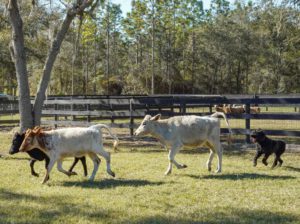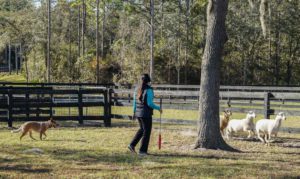The 2021 Black Prong Larry Painter Herding Clinic, organized by Kathy Walker of Island Dog Academy, took place from December 1-5. This multi-day clinic brought dog-handler teams from across the U.S. for the opportunity to learn from Larry Painter, a well-recognized herding dog trainer, and clinician. The clinic provided opportunities for handlers to work their dogs with sheep and cattle, under Painter’s instruction. Participating handlers had two working sessions per day, and were able to watch and audit the other trainer’s session with Painter. The clinic accepted both beginner and advanced handlers, and herding breed dogs of all levels.

Larry Painter instructing a handler.
Painter is based in Kansas City, MO where he and his wife, Marilyn, run Kuawarri Kennels, an Australian Cattle Dog and Australian Kelpie breeding and training operation. They take pride in preparing their dogs to be versatile enough to work different types of livestock and regularly work them with sheep, goats, and cattle. Painter travels year-round and offers monthly herding clinics nationwide.
Clinics benefit handlers and dogs by allowing them to hone their skills in a controlled setting with an experienced trainer offering real-time advice. Though dogs have been used in livestock management for centuries, sheep herding competitions, or trials, first began in the 1800s in New Zealand. As the sport grew in popularity in Australia and the regions that make up the UK, handler technique and herding dog breeding were refined. Today, dogs are still used in day-to-day livestock management, but many handlers train their herding dogs as a recreational activity or in preparation to compete in herding trials.
This is the fourth year Walker has organized the herding clinic with Painter at Black Prong. She says the facility is ideal for their learning environment due to the on-site dog-friendly accommodations, well-maintained pens, and natural farm setting.

Cattle worked by a Bouvier des Flandres.
Painter’s reputation as the “cattle dog guru”, as Walker called him, makes his clinics highly sought after by handlers. Painter’s teaching style is quiet, patient, and rooted in years of experience training with herding dogs. Beyond the appeal of working with such an experienced clinician, many participants come for the opportunity to work with cattle, because they are generally less available to train with than sheep.
Tish Webb got into herding for the fun of it and because her Australian Cattle Dog was bred for the job. She traveled from Massachusetts for her second clinic with Painter and for the opportunity to train with cattle under his guidance.

Tish Webb and her Australian Cattle Dog working sheep.
“I went to my first herding clinic with Larry because a bunch of my cattle dog friends had worked with him, and he breeds cattle dogs, so he really gets them,” Webb said. “He is just so clear, and kind, and patient with us as we learn, which is why I came back. Eventually, I hope to trial, but I live in Massachusetts and so it’s a little harder to find stock to train with.”
Herding dog breeds were developed for their instinctual ability to gather, herd, and protect livestock. Today many of these breeds have become popular family pets, but they excel when they are given a job. These intelligent breeds are highly trainable and excel in competition disciplines such as obedience and agility. Additionally, these breeds are commonly used for police, protection, and search and rescue work.
Some of the most well-known herding breeds are the Australian Cattle Dog, Australian Shepherd, Bouvier des Flandres, Old English Sheep Dog, Border Collie, Welsh Corgi, and the German Shepherd.
